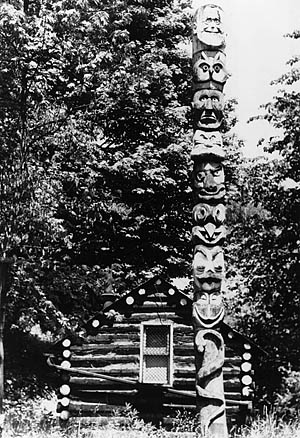
Dr. Chesney Ramage erected this 24-foot totem pole on a hill overlooking Fairmont in the early 1940s, where it stood until 1984. Photograph by John Champ Neeley.
Chesney’s Totem Pole
Tribute to a Fairmont Landmark
By Raymond Alvarez
On a warm fall afternoon in 1965, my freshman civics class at Fairmont Senior High was made more interesting by the prospect of an after-school hike to see a famous landmark — a totem pole located atop View Avenue. The trek was organized by classmate Jack Lindsay, who claimed it was a unique and interesting artifact, located on a hill overlooking all of the downtown area. Not being that familiar with Fairmont, as I was a bus student from the northern outskirts of town, I decided to tag along, figuring I could catch the City Lines bus to Meredith Springs later that day. Besides, I had never seen a totem pole up close and in person, and I felt honored to be included in the adventure.
As Marion County students, we knew a little about the Native Americans from our area, mostly nomadic Shawnee tribes who followed the rivers to fertile hunting grounds. We were taught that the name of the river that formed at Fairmont came from an Indian term meaning “caving banks.” We also learned that an Indian mound once existed near 2nd Street and Fairmont Avenue on the former site of the second campus of Fairmont Normal School. The ancient mound and the Victorian structure housing the normal school were long gone, as a modern post office and federal building was constructed on that site by the 1940's. Fairmont Normal School became known as Fairmont State Teachers College when the new campus was constructed at its present-day site on Locust Avenue in the mid-1920's. The college yearbook became known as The Mound in reference to the historic site of days long gone. However, I never knew a totem pole still existed in the town. This was news to me.
A highly energized Jack led a small group of freshmen boys from Oakwood Road across Locust Avenue to Bryant Street, where we climbed higher until we reached View Avenue. We hiked about a mile across View overlooking Watson Avenue, where some of the first prominent homes of Fairmont were constructed. We crossed over to Quarry Avenue, which ended at a private road called Circle Drive. Our destination, Jack explained, was right over a small rise. We ended up on the north side of the hill, and the vista of Fairmont was beautiful. From this wooded precipice, the city bustled below in a miniature collection of interconnected buildings and streets. All the trees on the surrounding mountains shone in gold, red, and russet colorings. We could see nearly all of East Fairmont on the other side of the meandering Monongahela River, beautiful and green, as light sparkled off the tiny ripples made by the warm breeze that sunny afternoon.
“There’s the totem pole,” Jack pointed out, interrupting my perusal of the town. When we got closer to inspect it, I wondered what kind of Indians erected such a thing.
“Is that Popeye?” I asked, gazing at one of the eight carved figureheads stacked along its 24-foot height. A woodpecker ignored us and chipped away on the face on the top. It was the likeness of Franklin D. Roosevelt. Despite its timeworn visage and faded coloring, it remained an imposing totem, but it was unlike anything I had ever seen in history books.
You can read the rest of this article in this issue of Goldenseal, available in bookstores, libraries or direct from Goldenseal.